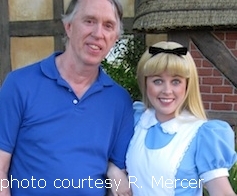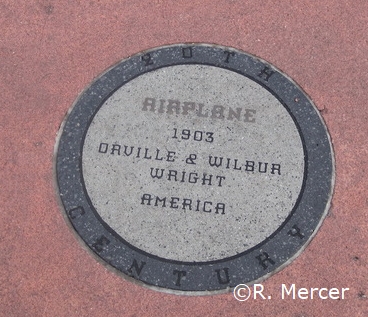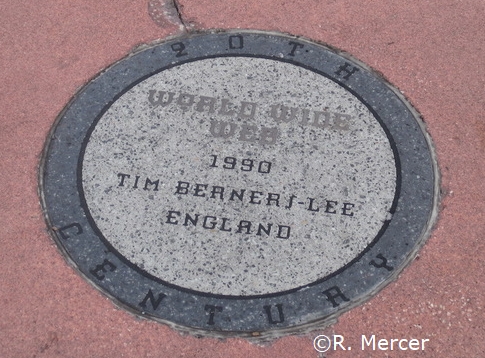The Science Disks of Epcot, Part 2
by Richard Mercer
AllEars® Guest Columnist
Feature Article
This article appeared in the August 21, 2018 Issue #987 of ALL EARS® (ISSN: 1533-0753)
Editor's Note: This story/information was accurate when it was published. Please be sure to confirm all current rates, information and other details before planning your trip.
CORRECTION/CLARIFICATION: In Part 1, the author noted that the disk for Internal Combustion Engine cited the country as England — it should have said France. Thanks to reader Kerry Somerset for pointing out this error.Also, please note that in general the country noted on the disk cites where the event took place, which may or may not match the nationality of the person or people involved.
===============================
On the path from the Epcot main entrance to Future World West (The Land, Living Seas, and Imagination), one encounters a collection of stone disks embedded in the pavement representing the great achievements of the human race in science and technology. Some are discoveries, some are inventions, and some are scientific theories. Last week, I recounted the 22 disks covering "The Early Years" and "The Industrial Revolution." In this part, I discuss the remaining disks, from The 20th Century.
The 20th Century
Fourteen disks belong to the 20th Century. An asterisk is used to denote Nobel Prize recipients.
Quantum Theory (1900) Max Planck* (Germany)
Max Planck discovered that the energy of radiation in certain experiments could only occur in discrete quantities (or quanta, plural of quantum). It was soon discovered that the energy radiated was contained in individual particles called photons whose energy was fixed by the frequency of the radiation.
Atomic Energy (1901) Marie* & Pierre* Curie (France)
A better name would have been "Radioactivity", as the Curies studied radioactive isotopes that release energy randomly. "Atomic Energy" suggests industrial-scale production of energy, as in Nuclear Reactor below.
Airplane (1903) Orville & Wilbur Wright (America)
Nobody ever says "Orville and Wilbur" as the disk does! It's always "Wilbur and Orville Wright." (Wilbur was older.)
Personal Note: In the Carousel of Progress, the father says "… And I even hear tell of two brothers from North Carolina who are working on some kind of flying contraption." The Wright brothers were not from North Carolina, though a disturbingly large fraction of Americans think they were. I live in the same city that the Wright brothers did, and worked at Wright State University, adjacent to Wright-Patterson Air Force Base. It was here in Dayton, Ohio, that the science, engineering, and experiments that led to human flight were done by the Wright brothers. Kitty Hawk, North Carolina, was chosen as the location for the first actual flight because it provided wind (to assist with takeoff) and sand (for a soft landing). The original Wright "B" Flyer can be seen at the National Air and Space Museum in Washington, DC.
Liquid Fueled Rocket (1925) Robert Goddard (America)
Wikipedia gives the first flight as March 16, 1926, using gasoline and liquid oxygen as the fuel components. As you probably know, if only from watching "Mulan", the Chinese used solid fuel rockets long ago, beginning in 1232 according to a NASA website.
Television (1928) Philo Farnsworth (America)
I'm sure that both the date and name will be a shock to most Americans. They will ask "What took so long?" and "Why have I never heard of him?" The answer to both questions is that it took time for all the necessary ingredients to come together. It was necessary for TV's to be mass-produced so that they were affordable, for broadcasters to go into business in major cities, for studios to arise that created programs, and for advertisers to decide to pay for those programs. It wasn't until the 1950's that Television really started to take off, and the early 1960's before color TV became common. One of the first programs to take full advantage of color TV was "Walt Disney's Wonderful World of Color" beginning in 1961.
Penicillin (1928) Alexander Fleming* (England)
Penicillin is the name of a family of naturally occurring antibiotics, which remain widely used.
Computer (1930) Vannevar Bush (America)
There was a continuous evolution of computing machines throughout the 20th century, and to pick out one as the "first computer" is completely arbitrary. The machine developed by Bush in 1930 was a special purpose machine called a "differential analyzer", which was not a general purpose programmable computer, but could only be used to solve differential equations numerically. I would not have chosen this machine as the "first computer."
Nuclear Reactor (1942) Enrico Fermi* (America)
Fermi did not create a working nuclear reactor as a power source, but rather created a self-sustaining nuclear chain reaction, showing that such a reactor was a possibility, and playing a role in the development of the atomic bomb. Fermi also produced important theoretical results in quantum mechanics and statistical mechanics.
DNA (1944) Oswald Avery (America)
Avery experimentally isolated deoxyribonucleic acid (DNA) as the substance in cells that carried genes. One could argue that discovering the structure of DNA was more important than just discovering DNA itself.
Transistor (1948) William Shockley*, John Bardeen* & Walter Brattain* (America)
The transistor is an electrical component with two input wires and one output wire, that can act as a switch or amplifier. In the 1950s it was used in portable radios, with fewer than 10 transistors.
The hardware side of the computer revolution has in a sense consisted of cramming more and more transistors onto an integrated circuit, leading to LSI (large scale integration) with tens of thousands of transistors on a chip, VLSI (very large scale integration) with hundreds of thousands or millions of transistors on a chip, and ULSI (unbelievably large scale integration) with billions of transistors. Just kidding about the name on the last one… but seriously, billions!
Personal Note: I laughed at the thought of an electrical engineer named Shockley!
Microprocessor (1971) Ted Hoff, Federico Faggin & Stan Mazor (America)
This refers to the Intel 4004, "generally regarded as the first commercially available microprocessor." Wikipedia notes that this was an international effort with Hoff and Mazor being American, Faggin being Italian, and also credits Mastoshi Shima (Japan). As the model number suggests, this was a 4-bit processor. (Modern processors are generally 64-bit.)
Genetic Engineering (1973) Stanley Cohen & Herbert Boyer (America)
This refers to the first GMO (genetically modified organism), a bacterium.
(Just one! "Bacteria" is plural.)
World Wide Web (1990) Tim Berners-Lee (England)
The Internet and the World Wide Web are not the same thing. The Internet originated in the 1960s as a government-funded project called ARPANET, which then grew to include a wide variety of computers. The Internet is a combination of hardware and software that uses a common protocol (TCP/IP) to connect computers. Prior to the World Wide Web there were other methods to access information on other computers via the internet that went by names like "gopher" and "lynx", but by the mid-90s the "web" became dominant.
Berners-Lee developed a protocol (HTTP) for accessing information on computers connected to the internet that were set up to make information available in this way, i.e. web servers, and provided software that made it relatively simple to set up a computer as a web server.
Antimatter (1996)
Antimatter has been around for a while in the sense of individual particles. A PET scan uses antimatter; PET stands for Positron Emission Tomography. The positron is the antimatter partner of the electron. Its existence was predicted by Paul Dirac* in 1928, and it was discovered in 1932. If a positron meets an electron they will both be completely converted to energy, i.e. annihilated. A PET scan begins by placing radioactive matter into your body by injection or other means, which then emits positrons. ("Tomography" is the mathematical process of reconstructing a 3D object based on information obtained from 2D slices.)
What happened in 1996 was that antimatter atoms of hydrogen were produced in a particle accelerator in Geneva, Switzerland. These atoms consisted of an antiproton together with a positron (antielectron). This was a neat trick but not deserving of recognition as a scientific breakthrough.
Significant omissions in the 20th Century include Relativity Theory (Einstein*), the Automobile, and DNA Structure (Watson* and Crick*). Carl Sagan facetiously suggested that aliens observing Earth from space might think that the dominant life form was the automobile!
What new technologies might we see in the not-too-distant future? This is the subject of a recent book titled "Soonish" by Kelly and Zach Weinersmith. I suggest you get it and read it!
Acknowledgement: Wikipedia was extremely useful in preparing this commentary. There are times when one needs a summary of the overwhelming amount of information available on a topic, and that's what Wikipedia did for me.
============
RELATED LINKS
============
The Science Disks of Epcot, Part 1
 = = = = = = = = = = = = =
= = = = = = = = = = = = =
ABOUT THE AUTHOR
= = = = = = = = = = = = =
Richard Mercer is a recently retired math professor living in Ohio. As a child he loved science and planned to become a scientist, but in high school discovered he was no good in the laboratory, so he did the next best thing and became a mathematician. An otherwise idyllic childhood did NOT include a visit to Disneyland. As an adult he has made up for this omission by purchasing a DVC membership and visiting Walt Disney World on a regular basis.
-o-o-o-o-o-o-o-o-o-o-o-
Editor's Note: This story/information was accurate when it was published. Please be sure to confirm all current rates, information and other details before planning your trip.























